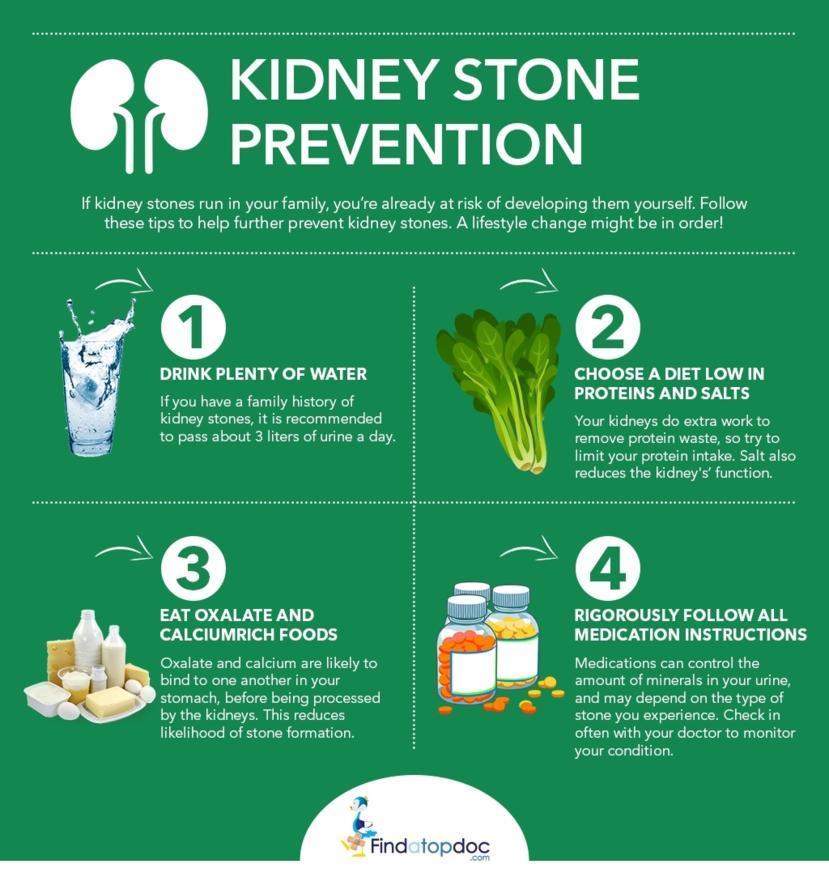Treatment for Kidney Stones

Kidney stones also called nephrolithiasis refers to ball-like structure that form in the urinary system of your body. These stones form as a result of solidifying of acidic salts and minerals filtered from the blood by the kidney. Once these crystals form they move down from the kidney into the bladder, ureter and the urinary tract.
The stones are made up of oxalates, phosphates, maleates and other materials. These are substances that are taken into the body and most of them can be prevented. Once they form they block urine passage and cause a lot of pain around the lower back and the abdomen.
The rate of infection for this condition is increasing and there is the need to treat and prevent more cases. Around 20% of the world’s population suffer from kidney stones. The condition is also common in men than women. In every 20 patients 5 are men while 1 is a woman.
Treatment for Kidney Stones
- Intake of high amounts of water. Lack of enough fluids in the body is the major cause of kidney stones where the body lacks enough fluids to dissolve the substances filtered from the blood. It is recommended to take up a minimum of 1.9 liters of water a day. This helps to clear out the urinary tracts.
- Traditional methods. This is mostly used when there are very large stones in the body. However, this is a very rare operation. During open surgery, an incision will be made in the back of the patient and then the surgeon will be able to access the ureter and kidney. These kinds of open surgery are very rare these days, given that less than 1% of patients require a surgery.
- Use of a scope. In this method, a doctor passes a thin light tube (ureterscope) into the ureter to the bladder with a camera to identify kidney stones. Once they are identified, special tools are inserted to crush the stones so that they can pass through urine or remove them. A plastic tube called a stent will have to be inserted inside the urethra, temporarily. This is to allow the stone fragments to drain into the bladder. It also serves the purpose of relieving the patient from swelling and promote healing. The patient may need a general or local anesthesia during this procedure.
- Surgery of the Parathyroid Gland.Some calcium phosphate stones are caused by overactive parathyroid glands.The Parathyroid glands are located close to the thyroid gland- to be precise they are located on the four corners of your thyroid gland, just below the Adam's apple. When parathyroid produce excess parathyroid hormones (a condition known as hyperparathyroidism), it increases the level of calcium in the body which forms kidney stones. The surgery targets into removing these glands to reduce kidney stones formation. Alternatively, the doctor may recommend treatment of the condition that causes the parathyroid gland to overproduce the parathyroid hormone. Sometimes, Hyperparathyroidism occurs when a small, benign tumor forms in one of the parathyroid glands.
- Use of sound waves. The process also well known as extracorporeal shock wave lithotripsy (ESWL). This procedure for treating kidney stones is generally resorted to when the stones cannot be passed in the urine. This is a process that is meant to break down the stones and enable them to be passed out in urine. The doctor uses sound waves though ESWL which produce very strong vibrations which breakdown kidney stones. It is an operation that has it side effects such as blood in urine and pain. It is done under anesthesia to reduce pain. The process takes between 45-60 minutes. Sometimes the patient may require more than one session of ESWL to successfully treat the kidney stones. ESWL is chosen for stones up to 20mm (0.8in) in diameter. ESWL is up to 99% effective for such stones.
- Pain Relievers. When someone has small stones they pass them out urine but it causes pain. Doctors recommend pain killers to help the patient pass out kidney stones with ease. These pain relievers may include; naproxen sodium, acetaminophen and ibuprofen.Nonprescription medicine, such as nonsteroidal anti-inflammatory drugs (NSAIDs), may also relieve the pain. But the patients have to exercise care before taking any over the counter drugs.
- Taking of calcium rich foods. This helps the body prevent production of calcium. Lack of enough sodium in the body leads to production of high amounts of calcium. Calcium combines with Phosphates, oxalates and maleates to form kidney stones.
- Taking the right diet. This is where a patient takes foods that do not contain chemicals responsible for formation of kidney stones. Such foods may include; animal proteins such as meat and fish which causes calcium oxalate and reducing intake of oxalate rich foods such as spinach and nuts.
- Percutaneous nephrolithotomy (PCNL). Larger stones in the kidney may be treated using an alternative procedure called Percutaneous nephrolithotomy (PCNL). In cases where ESWL is unsuitable, the PCNL may be suggested. For instance, if a person is obese and has kidney stones, the PCNL may be chosen instead of ESWL. A thin telescopic instrument called as nephroscope is used in this procedure. A small incision is made in the back of the patient and the nephroscope is passed through it and into the kidney. The stone is either pulled out or broken into smaller pieces using a laser or pneumatic energy. PCNL is always carried out under general anaesthetic, the effects of which will last for up to 48 hours after the procedure. Generally, this procedure works well for stones that are 21-30mm (0.8-1.2in) in diameter. PCNL is 86% effective for such stones.This procedure is also known as Tunnel surgery.
The Bottom Line
Treatment for kidney stones can also involve admission in the hospital. Whenever a patient has very many and large stones, a doctor can admit the patient to take a comprehensive treatment including extraction of the stones. Methods used for treatment are also part of prevention measures for recurring kidney stones. Realising as to when to consult medical aid is very important, and with kidney stones one should never take a risk as the pain is excruciating.










